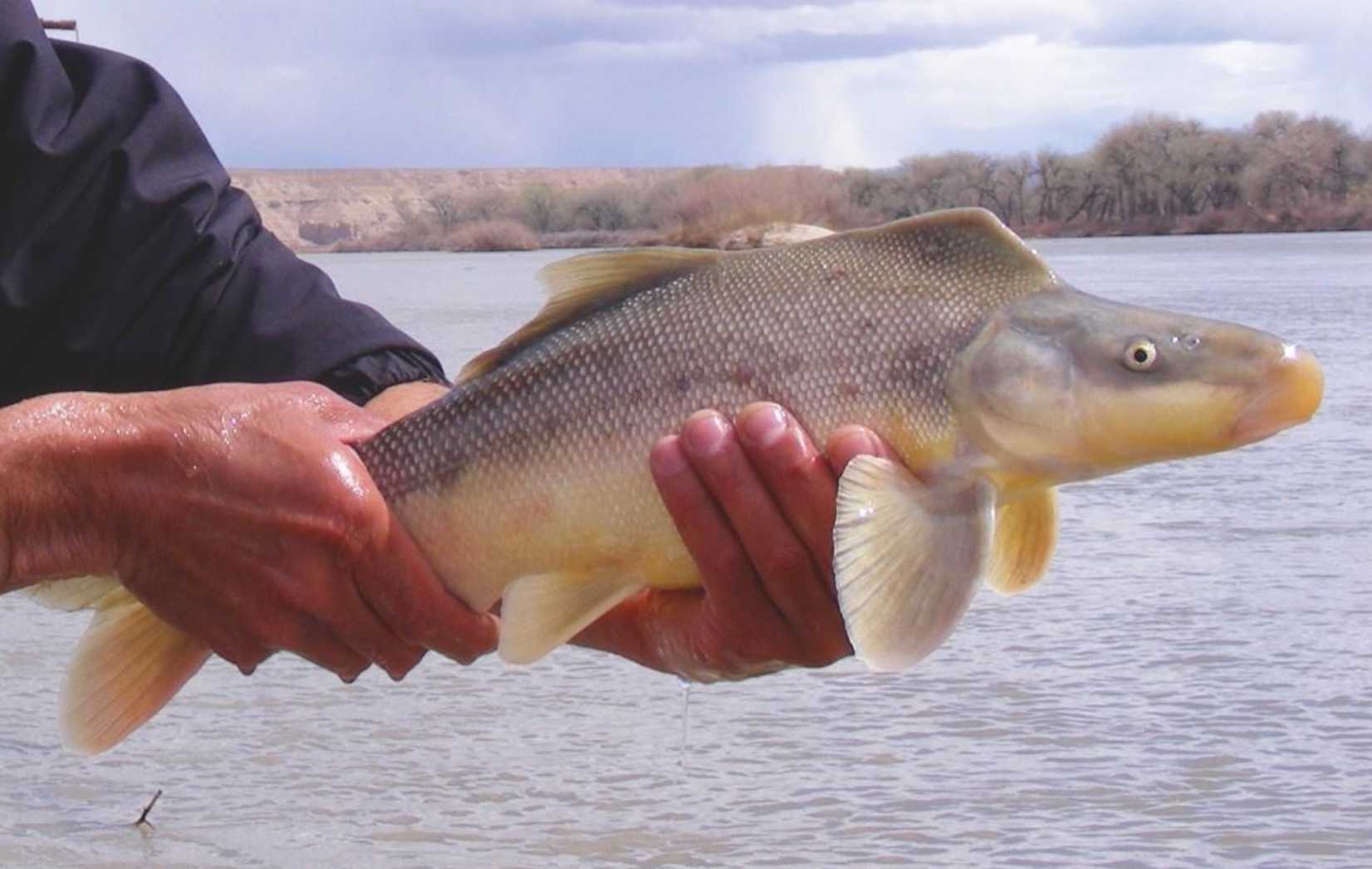The Razorback Sucker is one of the most iconic and imperiled native fishes in the Colorado River. It has also been the subject of expensive conservation efforts, which have thus far proved only marginally effective. As new threats emerge the struggle has moved from the hatchery into the courtroom.

Most would agree that the Razorback Sucker is not a pretty fish. These odd-shaped, long-lived fish don’t taste very good either. Yet the fate of these fish, which evolved in a wild Colorado river around the time of the Mastodon, provide a crucial insight into a changing river and the valiant efforts to reconcile human desires with the needs of native fish.
The Razorback, which can grow to 36 inches in length and weigh up to 14 pounds, is recognisable by the sharp-edged bulge on the front part of its back, between the head and dorsal fin. This odd shaped hump gives rise to its common name, as well as to the alternative name "humpback sucker". The back of the fish is olive to brown-black, its sides are brown or pinkish, and its belly is white to yellow. Adults can live up to 40 years old, but there appearance makes them feel ancient.
The Razorback was once abundant throughout the Colorado River basin. It is now near extinction in the in the lower Colorado River basin where the only substantial populations remaining are in the manmade Lake Mohave, Lake Mead and Lake Havasu. Populations in the upper Colorado River and tributaries are extremely low. The fish was assumed to be nonexistent in the iconic Grand Canyon, but recent surveys have found a few adults as larvae (Rosner 2010).
The reasons for the decline of the Razorback all come down to us, or more specifically, the particular way the recent human inhabitants of the basin have chosen to live. Threats to the fish such as, alteration and fragmentation of habitat due to dams, altered river flow and degraded habitat from water diversion, introduction of nonnative fishes, livestock grazing, climate change, and pollution, can all be traced back to relatively recent changes in the human occupation of the basin[1]. Agriculture, industry, and the growth of cities has fundamentally reshaped the way that water flows in the Colorado River Basin. Changes to water quantity and quality have been drastic not only in their scale and scope, but in their speed. Native species, such as the Razorback, have coped with drastic changes in the past, yet the rates of change they experienced in the last 50 years have been faster than any 50 year period in the previous 4 million. They can’t keep up.
Thus far efforts to help Razorback cope with these rapid changes have heavily relied on the use of fish hatcheries, where juvenile fish are raised in controlled environments, protected from predation by non-natives and the colder waters of the dam-controlled Colorado. By some measures, these hatcheries have been a success (Brennan, 2017). They have successfully raised millions of fish. However, once released, these hatchery raised juvenile fish have fared poorly in the wild, likely due to predation (Rosner 2010). A newer and more successful approach, called repatriation, essentially protects the juveniles for longer. This new approach was influenced by findings that older (more mature) fish are less likely to be eaten by predators (Brennan, 2017).
This new approach is expensive and relies on the ongoing support of federal and state agencies. As it stands, the Razorback is a prime example of a conservation-reliant species, which require continuing species-specific wildlife management intervention to survive, even if a self-sustainable recovery in population is achieved (Goble et al. 2012). In this way the fate of the fish is tied to the fate of these agencies and the laws they are enforcing. Those who fight to bring back the Razorback realize that many threats it faces cannot be eliminated, but only managed (Brennan, 2017).
Meanwhile new threats are emerging. For example, recently developed land-use plans would allow nearly 19,000 new oil and gas wells in western Colorado. In addition to diverting more water out of the Colorado river, these energy developments pose serious water quality threats, to which native fish species are particularly sensitive. In September of 2016, the Center for Biological Diversity filed a lawsuit against the Bureau of Land Management and U.S. Fish and Wildlife Service for their role in expanding fracking in western Colorado[2].
In order for the Razorback to persist in the wild conservation efforts must continue and the new threats must be stopped. However, hatcheries and lawsuits working in tandem can still only do so much to manage the threats to the Razorback’s survival. The underlying pressures on the Razorback and the other endangered native species in the Colorado River are directly tied to our way of life. As long as agriculture, industry and cities continue to demand massive amounts of water and energy from the river and pollute the water they return to the system, the fate of these fish will be in peril.
Therefore, the long-term persistence of these fish depends on a radical change in the way we farm, manufacture, grow or degrow cities in the Colorado River Basin. The Razorback has persisted for millions of years, through droughts, floods and a changing climate. Now its fate is tied to us and our ability to adapt our way of life to yet new changes occurring at an unprecedented rate. These changes threaten the viability of communities in the Colorado River Basin. Can we adapt like the sucker and persist? And if we do, can we insure that future generations get to experience and learn from this odd-looking fish?

References
Goble, Dale D., John A. Wiens, J. Michael Scott, Timothy D. Male, and John A. Hall. 2012. “Conservation-Reliant Species.” Bioscience 62 (10). Oxford University Press: 869–73.
Rosner, Hillary. 2010. “One Tough Sucker.” http://www.hcn.org/issues/42.10/one-tough-sucker.
Brennan, Reid. 2017. The Conservation Status of the Razorback Sucker in the Colorado River Basin. Presentation to the Grand Canyon Class 2017.
